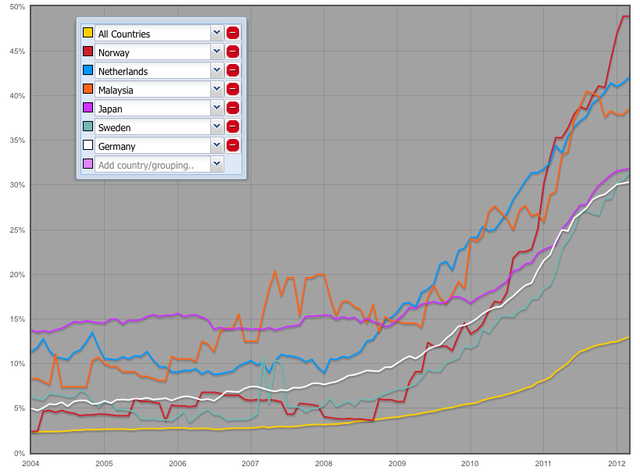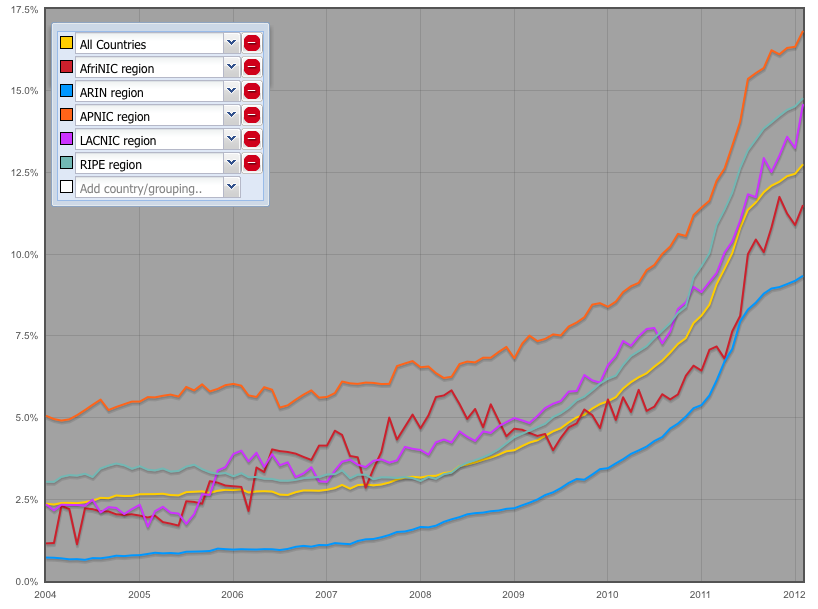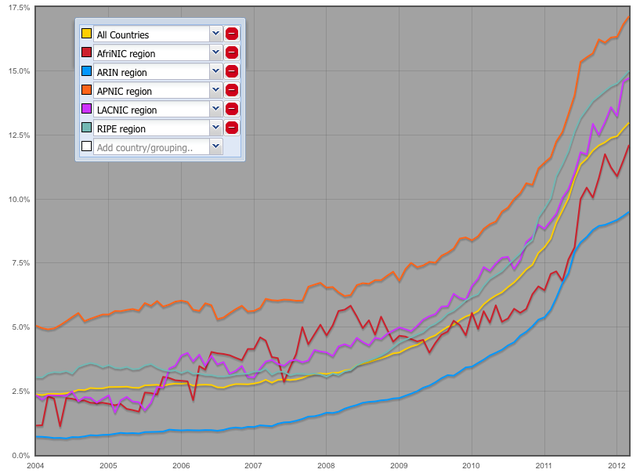One year after we released the interactive graph to show the percentage of ASes announcing IPv6 prefixes, we looked at the progress made since then.
Over a year ago, we developed an interactive graph showing the percentage of IPv6 enabled networks over time (starting in 2004). More precisely, it showed the percentage of Autonomous Systems (ASes) that announced one or more IPv6 prefixes in the global routing table. This tool was initially described in Interesting Graph - Networks with IPv6 Over Time on RIPE Labs.
Back when this article was posted, the percentage of ASes announcing one or more IPv6 prefixes in the five Regional Internet Registry (RIR) service regions were approximately:
- APNIC 10%
- RIPE NCC 8.5%
- LACNIC 8.5%
- AfriNIC 6%
- ARIN 5%.
Now more than a year later, we looked at the progress since then. In the image below you can see the current status in all regions (NOTE: When you click on the images it will bring you to the most up to date version of the graphs).
Figure 1: Percentage of IPv6 enabled networks in all RIR regions
The percentage of IPv6 enabled networks has increased in all regions. In the APNIC region close to 17% of all ASes announce one or more IPv6 prefixes, in the LacNIC and the RIPE NCC region between14 and 15%, in the AfriNIC 11.5% and in the ARIN region almost 10% of all networks are IPv6 enabled.
Now, the percentage of ASes announcing one or more IPv6 prefixes in the RIR regions are approximately:
- APNIC 17%
- LACNIC 15%
- RIPE NCC15%
- AfriNIC 12%
- ARIN 10%.
It is interesting to note that the graphs for most regions show some flattening after a rather steep increase earlier last year (around the time the IANA allocated the last IPv4 address space to the RIRs).
We then looked closer at the countries with the highest IPv6 penetration at the AS-level worldwide. In order to show comparable countries, we filtered out those countries with less then 50 ASes. The top 6 countries worldwide are shown in Figure 2.

A year ago, the Netherlands showed the highest percentage of IPv6 enabled networks with 31% and it is still growing strongly (now at 41%). But it has now clearly been surpassed by Norway which made a huge leap over the last year and especially since November 2011 and is now showing almost 50% of ASes in the country announce one or more IPv6 prefixes. It would be interesting to find out what caused this increase of IPv6 deployment in the country.
Note that 7 out of the top 10 countries are located in the RIPE NCC service region. It is also interesting that all Scandinavian countries are among the top 10 European countries and the top 12 worldwide.
| Country | % of IPv6 Enabled ASes | Number of ASes |
|---|---|---|
| Norway | 48.9% | 135 |
| Netherlands | 42.0% | 445 |
| Malaysia | 38.5% | 96 |
| Japan | 31.8% | 550 |
| Sweden | 31.3% | 383 |
| Germany | 30.3% | 1125 |
| Belgium | 29.9% | 137 |
| Ireland | 28.7% | 101 |
| Finland | 28.2% | 142 |
| Singapore | 28.0% | 164 |
| New Zealand | 27.9% | 219 |
| Denmark | 27.7% | 173 |
| Switzerland | 26.8% | 418 |
| Austria | 25.8% | 330 |
| Portugal | 24.5% | 53 |
| France | 22.2% | 580 |
| Taiwan | 22.0% | 118 |
| South Africa | 21.6% | 125 |
| Slovenia | 21.1% | 227 |
| Hong Kong | 20.1% | 278 |
Table 1: Top 20 countries showing highest IPv6 penetration at the AS level






Comments 10
The comments section is closed for articles published more than a year ago. If you'd like to inform us of any issues, please contact us.
gert •
how do you map AS numbers to countries?
Mirjam Kühne •
Hi Gerd, the methodology is described on http://v6asns.ripe.net below the graph. If you have any aditional questions, please let us know. Mirjam
gert •
thanks for that. I think I need to do some polishing of my own routing table pictures :-) (I currently have the "total number of ASes in the IPv6 routing table" but not "per-RIR" or "per-country"). Good to know that the stats files are "accurate enough".
Jan Zorz •
In Norway, probably IPv6 summits and events, organized by Torgeir, Ragnar, Linda and other people from Norwegian IPv6 Forum - they did some really good job, I can tell you from first hand experience :) They are up for another IPv6 event in April in Oslo. http://ipv6forum.no/ Jan
Ragnar Anfinsen •
What Jan said... ;) Jokes aside. We have been working for a while with both the industry and the regulators, raising awareness amongst LIR's. It is truly joyful to see the results for the work we have done for the last year and a half. Ragnar
Ragnar Anfinsen •
Just looked quickly at the dates where the Norwegian graph had some leaps, and they correspond nicely with the following: 2010-11: Norwegian Post and Telecommunications Authority first national meeting. 2011-05: IPv6 Forum Norway's first IPv6 Summit. Announced 2011-04. 2011-11: IPv6 Forum Norway's second IPv6 Summit. It will be exiting to see if anything happens after april, the third IPv6 Forum IPv6 Summit. Ragnar
Dick •
So the US is below the 20th place?
Emile Aben •
US is 46 out of the 62 countries that have more then 50 ASes
Mike •
The U.S. is still benefitting from the fact of controlling the largest blocks of IPv4 address space to begin with.
Daniel Karrenberg •
Be aware that this particular statistic has the bias of a relative measurement of widely varying populations. In order to change by 10% Norway needs 14 ASes to change while Germany needs 113 ASes to change. Also it is important to note that this says nothing about actual usage of IPv6 or how widely IPv6 is actually available. The statistic is interesting and relevant, but as always be aware of how it is derived.